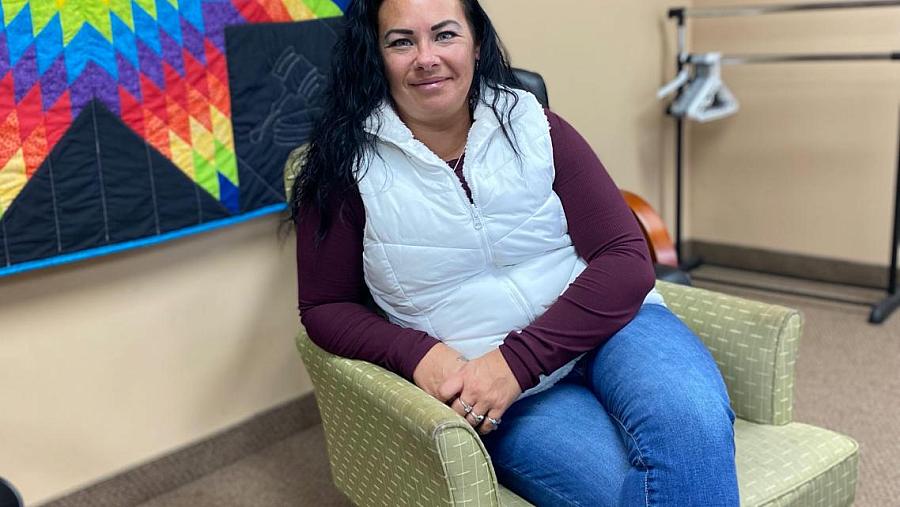Exploring high rates of Native Americans in foster care helps a reporter become the journalist she wants to be

Jessica Washington's fellowship reporting told the story of Teresa Nord, above, a Navajo and Hopi Indian descendant who lost custody of her daughter after she was removed by child protective services in Minnesota.
(Photo by Jessica Washington/The Fuller Project)
It was a year after George Floyd’s murder by Minneapolis police officers, and Jessica Washington was investigating another story of racial injustice in Minnesota that had never attracted the same attention.
Washington was reporting on gender and racial justice issues for The Fuller Project, a nonprofit news organization reporting on women, when her sources suggested she look at the foster care system in Minnesota. Worth her attention, they advised, would be the extreme disparity in the number of Native American children in foster care.
The statistics were stunning: Native children account for less than 2% of children in the state but roughly a quarter of the children in foster care. If someone is young and Native American in Minnesota, they are 17 times more likely than a non-Native child to end up in foster care. This disparity is the highest of any state in the country.
Washington’s reporting would show that the foster care system in Minnesota plays a part in a long history of racist practices for earlier generations of Native American children who were forcibly separated from their families on a massive scale through “Indian boarding schools” and adoption by white families.
Support she received as a Center for Health Journalism National Fellow enabled Washington to spend eight months investigating the practices of Minnesota’s child welfare system and its impact on Native families. Without that support, Washington says, she wouldn’t have been able to do the story justice.
“I wouldn’t have had the opportunity to do something like this,” she said. “I’d never been given the bandwidth to do a story this long and with this kind of depth. The fellowship gave me that, but it also gave me the confidence and the skills to do something this ambitious.”
Her 1,200-word story ran in the Minneapolis Star Tribune, the state’s leading newspaper, while a longer, 5,000-word version was published in Mother Jones magazine. It documented how the lack of diversity and cultural knowledge among social workers in the state, as well as longstanding economic and racial inequities, help drive Native children into the foster care system at disproportionate rates.
As she talked with dozens of people, it became clear that for many Native mothers, the fear of having their children ripped away was felt across generations of Native American families. Washington tells the stories of several women who have seen both sides of the foster care system — both as children themselves once in the system and as mothers who lost their own children to foster care.
Without the fellowship, Washington said, “I wouldn’t have been able to travel to Minnesota and sit in the homes and workplaces of the women I interviewed for this story. I would have missed a lot of the complexity. I would not have gotten the richness that their stories deserved.”
Washington had never taken on a major investigative project before, much less one focused on communities more than 1,000 miles from her home. But the fellowship’s practical training taught her how to manage a large project and stay on track, easing her fears and allowing the story to emerge organically.
“The Fellowship gave me a lot of opportunities for growth,” she said. “My Fellowship mentor, Sonny (Albarado), was incredible. Sonny really helped give me the confidence to keep going and keep pushing – and to make sure I was being as honest and truthful in my writing as I was in my reporting.”
I’d never been given the bandwidth to do a story this long and with this kind of depth. The fellowship gave me that, but it also gave me the confidence and the skills to do something this ambitious. JESSICA WASHINGTON, FELLOW
And knowing she had a lot to learn about Native American culture, she found the monthly gatherings with other fellows incredibly helpful. Many of them had reported on Native communities for years, including one reporter who was Native American herself. Washington strived to bring extraordinary empathy and nuance to her reporting, taking care to avoid glib stereotypes of Native American communities often found in journalism.
For Washington, taking on such an ambitious, complicated story was a leap of faith. But with the support from her fellowship, it proved to be the kind of leap that would propel her work to the next level. Washington now serves as a senior reporter at the Root, a digital publication focused on Black news and Black views.
“This story and the relationships I formed with my sources in Minnesota helped me get closer to the kind of reporter I want to be.”
